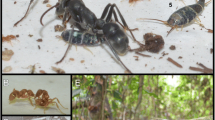Summary:
Nestmate recognition was studied in the Neotropical stingless bee Melipona panamica, a species in which workers “sneak” their own reproductive eggs into 1 % of brood cells. We manipulated four factors that could influence individual recognition cues: the mother queen, the environment during the immature stage, the environment during the early adult stage, and worker age. We also simulated the action of natural enemies on colonies tested for discrimination of such worker characteristics. All factors that we tested affected responses of the discriminating workers, which could recognize sisters, nieces and unrelated workers. Previous exposure of unrelated callow bees to the odor of the host nest greatly increased chances of acceptance by the host colony. Probability of acceptance decreased, however, with increasing age of introduced bees or increasing disturbance of the host colony. These complexities in patterns of nestmate recognition and nest defense are adequately explained from the standpoint of inclusive fitness of the discriminating workers. Differences in nestmate recognition and worker egg laying among Meliponini are also discussed.
Similar content being viewed by others
Author information
Authors and Affiliations
Additional information
Received 5 December 1997; revised 13 April 1998; accepted 27 Mai 1998.
Rights and permissions
About this article
Cite this article
Inoue, T., Roubik, D. & Suka, T. Nestmate recognition in the stingless bee Melipona panamica (Apidae, Meliponini). Insectes soc. 46, 208–218 (1999). https://doi.org/10.1007/s000400050136
Published:
Issue Date:
DOI: https://doi.org/10.1007/s000400050136




